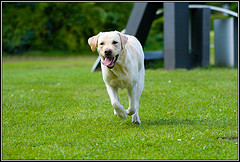Labrador dogs are among the easiest dogs to train due to their high level of intelligence. However, training Labrador retrievers appropriately requires you to use methods that will help them to grasp the concepts you are trying to teach. Dogs naturally want to please the leader of the pack. When you become a dog owner, you become that leader. Positive reinforcement is one of the best ways you can use to train your Labrador to follow your commands.
 Praise is a crucial element when working with Labrador dogs. They want to know that you are happy with what they are doing. While it may feel natural to scold your puppy when he does something he shouldn’t, negative reinforcement can often have the opposite effect you want. Therefore, it is best to try to ignore improper behaviors and make a big deal out of what your puppy is doing right instead. However, some behaviors just can’t be ignored. In these cases, it is best to distract your dog with a new activity instead of scolding.
Praise is a crucial element when working with Labrador dogs. They want to know that you are happy with what they are doing. While it may feel natural to scold your puppy when he does something he shouldn’t, negative reinforcement can often have the opposite effect you want. Therefore, it is best to try to ignore improper behaviors and make a big deal out of what your puppy is doing right instead. However, some behaviors just can’t be ignored. In these cases, it is best to distract your dog with a new activity instead of scolding.
Treats are another great tool for training Labrador retrievers. This type of positive reinforcement will help your dog associate specific behaviors with something pleasant, such as a tasty treat. Once a specific behavior becomes a habit, Labrador dogs will no longer need the constant treats to reinforce the behavior. In the early stages, however, it is important to give treats often when your dog is behaving himself. This will help encourage him to keep doing the good behaviors and help him forget the bad.
Another important element to positive reinforcement when training Labrador retrievers is to avoid using the crate as a punishment. While it is appropriate to punish your dog in certain situations, such as accidents well after the potty training period, the crate should never be part of that punishment. Instead, the crate should be used as a safe haven for your Labrador. For instance, it is a good place to put him when you are not going to be home or while you sleep.
When it comes to training Labrador retrievers, the use of positive reinforcement is critical to quick learning. Giving your dog praise and using other positive actions, such as patting him on the head or petting his back, will help to encourage a behavior. In addition, you can use treats in the early stages as training to give him a little extra incentive. Avoiding the use of the crate as a punishment tactic will also help encourage positive behavior in your pet. When you show him you are pleased, you are bound to get more of the same results.











